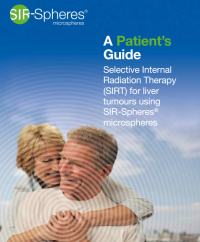Selective Internal Radiation Therapy (SIRT)
SIRT (also known as radioembolisation) is a targeted treatment for liver tumours that delivers millions of tiny radioactive beads called SIR-Spheres� microspheres directly to the liver.�
Radiation therapy can be an effective treatment for cancer and is often an important option for patients.� SIRT allows a dose of internal radiation up to 40 times higher than conventional radiotherapy, while sparing healthy tissue.� This procedure is approved for the treatment of liver tumours that cannot be removed by surgery.� These tumours may have spread to the liver from another part of the body (and are therefore called secondary liver cancer or metastases) or they may have started in the liver (also known as primary liver cancer).�
Clinical studies in patients with colorectal cancer that has spread to the liver and are inoperable have demonstrated that, compared to chemotherapy or standard therapy alone, SIR-Spheres microspheres may shrink liver tumours, improve quality of life and increase life expectancy.� For more information on SIRT, please refer to the downloadable leaflets or email us�at�[email protected]���SIR-Spheres is a registered trademark of Sirtex SIR-Spheres Pty Ltd.
About bowel cancer that has spread to the liver
What is the role of the liver?
The liver is the largest solid organ in the body. It has more than 600 different functions that include:
- Filtering unwanted substances from the blood
- Making most body proteins, including blood clotting factors, hormones and cholesterol
- Producing bile, a fluid that aids digestion of fat
- Storing glucose and vitamins
- Enabling quick energy release
- Removing toxins
- Helping to fight infections
What is secondary liver cancer?
Secondary liver cancer is cancer that started elsewhere in the body and then spread (or metastasised) to the liver. For this reason it is sometimes called metastatic cancer. Among patients diagnosed with bowel (or colorectal) cancer, the liver is the predominant site of metastatic disease.
�
How does a cancer spread to the liver?
When a cancer forms in part of the body, a few cancer cells may break off and find their way into the bloodstream. Because the liver filters the blood, any cancer cells in the bloodstream have a high chance of settling in the liver to form a cancer nodule (metastasis).
People who are most at risk of secondary liver cancer are those with cancers of the large bowel (colon), rectum, pancreas, breast, ovary, stomach, or lung.
The liver is the most common site for the metastasis of colorectal cancer; this is because the bowel is directly connected to the liver by blood vessels.
�
How do liver metastases affect colorectal cancer patients?
- About half of colorectal cancer patients will eventually develop liver metastases
- It is estimated that around 15-20% of colorectal cancer patients will present with liver metastases at their first diagnosis, with a further 25�35% developing liver metastases over the course of their disease
- Liver metastases from colorectal cancer can be life-threatening
- Surgical removal of the liver tumours is currently the only potentially curative intervention for patients with liver metastases from colorectal cancer. However, at present, only around 20% of patients will be eligible for surgical removal
- In some cases the use of chemotherapy, biological drugs and/or Selective Internal Radiation Therapy (SIRT), can reduce the size of unresectable (inoperable) liver tumours to allow surgical intervention
�
What is SIRT?
SIRT (also known as radioembolisation) is a special type of radiation therapy that targets liver tumours with high doses of radiation delivered inside the body. SIR-Spheres� Y-90 resin microspheres are the most commonly used form of SIRT where millions of tiny radioactive resin �beads� called microspheres are injected through a catheter into the hepatic artery that feeds liver tumours with the oxygen-enriched blood they need to grow.
The microspheres are only about one third the width of a human hair and lodge themselves in and around liver tumours where they emit high doses of tumour-killing radiation. However, as the microspheres only emit this radiation over a small area, they can target the tumour with minimal damage to the healthy liver tissue around the tumour. The radiation destroys the tumour cells, causing the tumours to shrink.
�
What is the SIRFLOX study?
SIRFLOX is an international research study that evaluated a new treatment option for patients with colorectal cancer that has spread to the liver. The study compared the results of adding Selective Internal Radiation Therapy (SIRT) using SIR-Spheres Y-90 resin microspheres to a standard treatment with chemotherapy alone.
�
What did the SIRFLOX study show, and what could this mean for me?
The SIRFLOX study results indicate that, in patients just diagnosed with unresectable liver metastases from colorectal cancer, the addition of SIR-Spheres Y-90 resin microspheres to standard chemotherapy extends the time before tumours in the liver start to grow again. This is important because the liver is the main organ where colorectal cancer spreads to first and these liver tumours most often cause the patient�s health status to decline.
Based on these results, SIRT is a treatment option that can be offered to patients with colorectal cancer that has spread to the liver. �Only your medical oncologist, in consultation with the multidisciplinary team, can assess if SIRT is right for you. Please contact your treating doctor to learn more about SIRT and the results of the SIRFLOX study. �
The results of the SIRFLOX study suggest that SIRT with SIR-Spheres Y-90 resin microspheres can be considered for timely use in patients with colorectal cancer that has spread only or mainly to the liver.
Please find below a Patient's Guide to SIRT in each language:
A Patient's Guide to SIRT in Arabic
A Patient's Guide to SIRT in Dutch
A Patient's Guide to SIRT in English
A Patient's Guide to SIRT in Finnish
�
A Patient's Guide to SIRT in French
A Patient's Guide to SIRT in German
A Patient's Guide to SIRT in Hebrew
A Patient's Guide to SIRT in Italian
A Patient's Guide to SIRT in Polish
A Patient's Guide to SIRT in Russian
A Patient's Guide to SIRT in Spanish
A Patient's Guide to SIRT in Swedish
A Patient's Guide to SIRT in Turkish
Please navigate to�http://sirtex.com/eu/patients/patient-support�for more information.




-(2).png)
.png)


